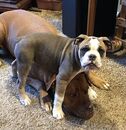- Sep 16, 2010
- 5,939
- 336
- Country
- Canada
- Bulldog(s) Names
- The Stig Racecar Driver and (Sweet Angel) Punkin Brutus
A friend of mine very recently had to put her eb/pug cross down because of the condition. Apparently she didn't show any symptoms and was diagnosed too late. Does anyone have experience with it or at least have some knowledge? My friend's having trouble finding anything with detail. 






